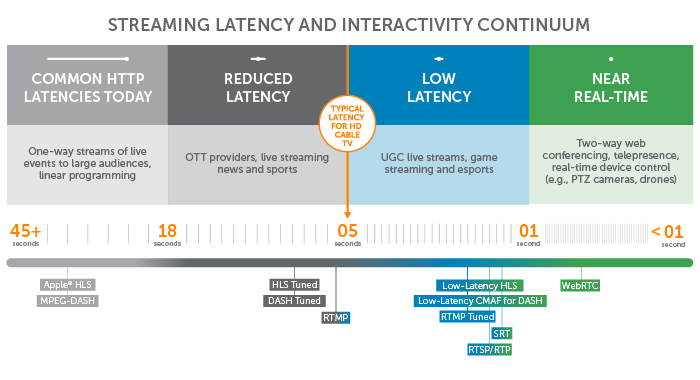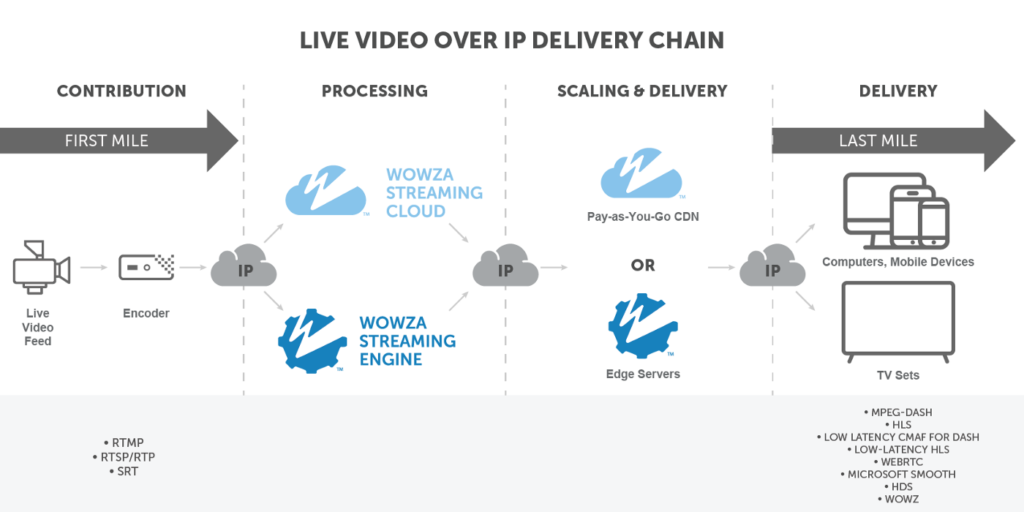Video latency of live broadcasts
What is latency in live video streaming?
Latency is the time in seconds or milliseconds that elapses between capture and delivery to the viewer.
This latency is related to several technical factors in the video transmission chain:
- Encoding of the video signal
- Stream ingestion and packetization
- Network propagation and transport protocol
- Internet delivery network (CDN)
- Segment length
- Viewer-accessible player configuration (buffering, resilience, etc.)
With traditional bitrate adaptive streaming, video latency is primarily dependent on the length of the media segment. For example, if your media segments are six seconds long, your player will already be six seconds behind the actual absolute time at which it requests the first segment.
In addition, each additional media segment that the player buffers before the actual start of playback increases the delay to the first decoded video frame.
Although many things generate video latency, the player itself bears a large part of the overall video latency.
Conventional, reduced, low, ultra-low and real time latency
Depending on the technical capabilities of the streaming provider you have selected, it will be able to provide you with a distribution of your video stream at different latencies to your viewers.
These latencies are usually expressed with “marketing” terms (normal, low or ultra-low latency) and correspond concretely to these times in seconds
- Conventional latency (or Normal latency): between 30 and 60 seconds
- Reduced latency: between 10 and 15 seconds
- Low latency: between 3 and 5 seconds
- Ultra-Low Latency: between 1 and 3 seconds
- Near real-time: less than 500 ms (0.5 seconds)
Be careful with the marketing and commercial terms used by the different suppliers. Sometimes, it is announced a latency time “ultra-low-latency”, or “real-time” for latency times of 8 or 10 seconds. It is therefore necessary to be careful with the effects of announcements and to look precisely at the real time differences proposed between the sending and the receiving of the flow.
Here is a reference table which summarizes the latency times according to the broadcast technologies:

The providers of streaming solutions for the general public such as YouTube, Facebook … generally offer a conventional or low latency streaming as an option.
These proposals are generally linked to their technical infrastructure and especially to the fact that they offer the broadcast of video content for free and to a very large number of users.
It is important to understand that to reduce this famous latency, it is necessary to technically improve several elements (encoding speed, speed of distribution of streams …). Quite simply, to encode video faster, you need more power. To increase the speed of the network, you need more bandwidth. All of this has a significant impact on the budget of the delivery to your viewers.
The shorter the latency, the higher the price of the broadcast! There is no miracle.
Although new technologies in the field of networking or video encoding are appearing (allowing to reduce the size of packets, to compress the video stream, to distribute it faster), the more we reduce the latency the more we limit the resilience and the guarantee of a good quality broadcast to the viewers.
By reducing the size of the buffer on the viewer’s player, for example: if some viewers have a slower internet connection, they may experience breaks in video playback or settle for poor viewing quality.
It is therefore necessary, for each type of streaming, to make a technological choice in adequacy with the requirements of the time lag between the capture and the viewing (interactivity, real-time reactions, speaking…). Estimate the type of audience targeted (number of spectators, location in the world, type of Internet connections, etc.).
Broadcasting solutions for your event
Online-Event offers you several technical solutions according to your needs and budget
Conventional latency
Online-Event offers you a solution for broadcasting on a conventional latency (normal latency) on WowzaMedia and Vimeo providers.
This latency time, around 30 seconds, is adapted for a broadcast without interactivity or with an interactivity limited to chat between users for example.
Technologies used:
- RTMP / RTMPS protocol for sending
- HLS or MPEG-DASH protocol for reception
Advantages :
- Very good experience for the viewers,
- Adaptive bitrate up to 8 formats guaranteeing a smooth and seamless playback, even in the case of viewers using a limited speed internet connection
- Broadcasting on a large CDN guarantees identical accessibility throughout the world
- Large playback buffer that can withstand interruptions of several seconds on the Internet line that sends or receives the video stream
Disadvantage :
- Significant time lag between the transmission and reception of the stream limiting the interactivity between the audience and the speakers (Quizzes, Q&A, MCQs ...)
Reduced latency
Online-Event offers a Reduced latency broadcasting solution on WowzaMedia and Vimeo providers.
This latency, between 10 and 15 seconds, is adapted for a broadcast with an interactivity limited to chat between users, Q&A, word clouds...
Technologies used:
- RTMP / RTMPS protocol for sending
- HLS tuned or MPEG-DASH tuned protocol for reception
Advantages:
- Good experience for the viewers,
- Adaptive bitrate up to 6 formats for smooth and seamless playback, even for viewers with limited internet connection
- Distributed over a large CDN to ensure equal accessibility worldwide
- Playback buffer supporting micro-cuts on the internet line sending or receiving the video stream
Disadvantage :
- Delay between the transmission and reception of the stream limiting the interactivity between the audience and the speakers (Quizzes, Q&A, MCQs ...)
Low latency
Online-Event offers you a low latency broadcasting solution on WowzaMedia and Vimeo providers.
This latency time, from 3 to 5 seconds, is adapted for a broadcast with a complete interactivity (reactive Q&A, Chat, QCM, word clouds ...)
Technologies used :
- RTMP / RTMPS tuned or SRT protocol for sending
- Low latency HLS (LHLS) or Low latency CMAF for DASH protocol for receiving
Advantages:
- Good experience for viewers,
- Adaptive throughput up to 4 degraded formats,
- Broadcasting on a powerful and adapted CDN guaranteeing a good accessibility in most countries,
- Large panel of interactivity possible between users and speakers (reactive Q&A, Chat, MCQs, word clouds, flying emoticons ...)
Disadvantage:
- Cost of broadcasting is higher than with conventional or reduced latency
- Cuts and loads can occur in case of limited internet connections for the viewers
- Cannot cope well with micro outages on the transmitting internet line
Ultra-low latency
Online-Event offers you a broadcasting solution with ultra-low latency on Ant-Media and SPARKUP providers.
This latency, from 1 to 4 seconds, is adapted for a broadcast with a complete interactivity (reactive Q&A, Chat, QCM, word clouds...)
Technologies used :
- RTMP / RTMPS tuned or SRT protocol for sending
- Websocket protocol for receiving
Advantages:
- Good experience for the viewers,
- Adaptive bitrate up to 4 degraded formats,
- Broadcasting on a powerful and adapted CDN guaranteeing a good accessibility in most countries,
- Large panel of interactivity possible between users and speakers (reactive Q&A, Chat, MCQs, word clouds, flying emoticons ...)
Disadvantage:
- Cost of broadcasting is higher than with conventional or reduced latency
- Cuts and loads can occur in case of limited internet connections for the viewers
- Cannot cope well with micro outages on the transmitting internet line
Near real time
Online-Event offers you a broadcasting solution close to real time thanks to WowzaMedia's RTS@S (Real time at scale) service
This latency time, less than half a second guaranteed, is adapted for a broadcasting with a great interactivity (Bidding, Votes, Video games, Sports, real time reactions ...)
Technologies used :
- WebRTC protocol for sending
- WebRTC protocol for receiving
Advantages :
- Good experience for the viewers,
- Adaptive throughput managed on multiple broadcast servers
- Broadcasting on a WebRTC CDN
- Any interactivity possible between users and speakers (Voting, Auctions, Quizzes, Rankings ...)
- Reception of the stream synchronized between users
Disadvantage :
- Cost of broadcasting is higher than on previous technologies
- Does not support any micro-cuts on the transmitting internet line (line backup highly recommended)
Real-time broadcasting technology
The “classic” streaming technologies (sending streams on RTMP or SRT protocol and receiving them in HLS) allow, by various technical means, to lower the latency time from 1 minute to a few seconds. The technologies and the protocols used remain the same as well as the type of CDN exploited for the global broadcasting on a large number of viewers.
Operation of a “Classic” streaming on a large scale :

Within the framework of a broadcast close to real time, the whole production chain is based on the WebRTC protocol which is the protocol used in video-conferencing (Zoom, Google meet, Jitsi…).
The operation of a real-time broadcast works as follows:

You can find more information about real-time streaming on this article dedicated to Wowza’s RealTime@Scale service.
